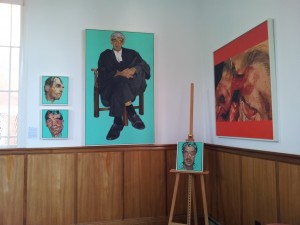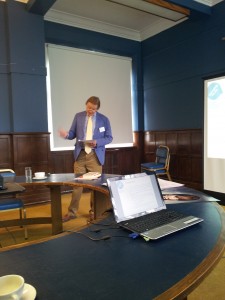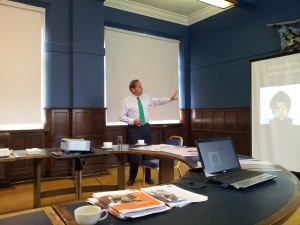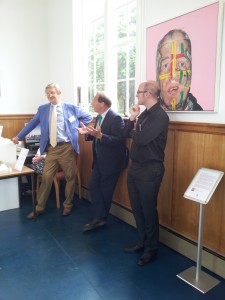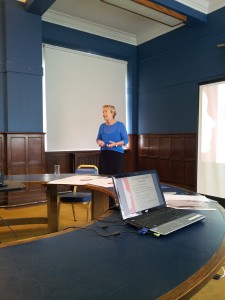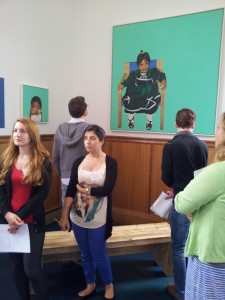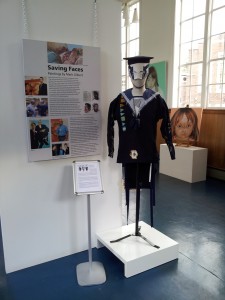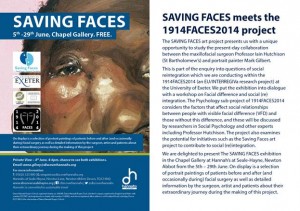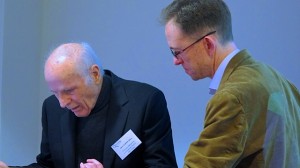18th September 2014, Innovation Centre, University of Exeter, Rennes Drive, Exeter
This workshop, co-organised by David Houston Jones, Joe Kember and James Ryan (University of Exeter) focused on the capacity of the archive to produce visual testimony. Given the special status of many of the archival collections concerning the facially injured soldiers of WWI and subsequent developments in medicine (including the Gillies archive, Tessier, Pont, Bridge collections), to enquire into the cultural history of the gueules cassées is also to scrutinise and assess the archive. As part of our inquiry into the cultural legacy of the gueules cassées, we examined the uses to which archival images have been put, from magic lantern slides to newsreel footage and the intertwining of the documentary and the fictional. More broadly, the workshop examined the documentary traces of the First World War with particular attention to photography and film; what is the significance of these and other visual media for our understanding of the legacy of the gueules cassées?
The topic was introduced by David Houston Jones, with brief reference to the epistemological questions arising from visual archival materials, and the complex relation of the archive to understandings of testimony. The workshop was situated in relation to the three strands of 1914FACES2014, and an update on progress to date was given.
Marjorie Gehrhardt’s paper was entitled, A ‘cruel testimony of the horrors of war’: visual representations of the Gueules Cassées in Interwar France’, and focused primarily on the film J’accuse (1938), in which gueules cassées featured. Gehrhardt’s analysis considered the positioning of facially injured soldiers in France as symbols of the brutality of war, with reference to the variety of representations of facially disfigured veterans in interwar France. Drawing upon visual material representing or made by the Association des Gueules Cassées, this paper evaluated the symbolism associated with facially disfigured veterans in interwar France.
Suzanne Steele’s paper, ‘Re-Facing War: VAD Mary Borden’s ‘Unidentified’ and The Forbidden Zone’, argued that VAD Mary Borden’s poem, ‘Unidentified,’ from her sui generis, The Forbidden Zone (1929), puts a new ‘face’ on the Great War canon and its vision of the conflict as a place of collateral and psychic destruction. Often overlooked in historical and literary accounts, the forbidden zone—the dangerous territory behind the lines in which Borden worked in a surgical unit—was a geographic, psychological and metaphoric site in which innovation, through necessity, fluid ethics, and opportunity, thrived. Steele argued thatthe hyper-kinaesthetic environment of la zone interdite was a site of sanctioned disorderand paradoxical agency wherein the artist re-created and innovated. ‘Unidentified,’ one of Borden’s poems, attempts to have the reader cast the gaze, to ‘re-face,’ not only the fallen soldier, but also, narcissistically, Borden herself.
Jason Bate, meanwhile, set out to examine the ways in which photography played a key part in the development of facial reconstructive surgery in England during the First World War. Bate’s paper focused on photography’s emergence in a set of medical discourses during the war years, which evolved from an initial focus on language, written and spoken, to one that necessarily included illustrations and specifically photography. But why did surgeons employ photography into their practice? What was the value attached to photographs, and what were photographs expected to do? How did surgeons read these images? What information did they convey? Bate started from the Foucauldian position that photographs can be categorised as visual records that could substantiate and articulate medical knowledge and moved on to look at medical journals published during the First World War. Bate argued that from 1916, photography was employed as a pedagogic tool to develop typologies of medical practice and to organise knowledge through visual means.
These concerns are closely related to those in Julie Mazaleigue’s ‘The Albéric Pont Archive: nature, functions and aims of visual representations of the Gueules cassées, from medical uses to testimony’. This material introduces the Albéric Pont Archive, recently acquired by the Inter-University Science Library of Paris-Descartes. The archive is mainly composed of visual representations: photographs of injured soldiers before and after surgical procedures, drawings of orthodontic apparels, and mouldings of injured faces. On the one hand, they obviously had a medical and surgical function, in terms of recording and of scientific transmission. The broader purpose of the paper, though, was to increase our understanding of the kinds and aims of the ‘testimonies’ which these documents provide, whether professional or sociological.
Other parts of the workshop broadened the conception of testimony which visual materials may be said to bring to bear upon the cultural history of WWI. Lawrence Napper (King’s College, London) spoke on British films of the 1920s and the ways in which they represent WWI. The first part of the analysis considered the various schemes proposed by the cinema industry in 1919 for the training of what were described as ‘disabled ex-servicemen’ into suitable jobs in cinemas, particularly as projectionists. Such schemes created widespread debate and anxiety within the cinema trade which was already struggling to cope with the pressure of employing demobilized ex-employees. The second half of the paper turned to two films offering different approaches to the figure of the disabled ex-serviceman in fiction films. The Garden of Resurrection (1919) can be read, Napper argued, as a romance centering on a hero suffering from facial disfigurement. The Guns of Loos (1928) features a hero who suffers from temporary shell shock – a psychological trauma represented primarily through facial performance in a series of startling close-ups. In both the film texts, and in the 1919 debate, the subject of facial disfigurement is alluded to, but never explicitly expressed
Beatriz Pichel (PHRC, de Montfort University, Leicester) spoke on ‘Historical Perspectives on the Medical Photographs of the Gueules Cassées: Disfigurement and Expression between 1870 and 1932’. The paper explored the photographic archive of the gueules cassées preserved at the Parisian hospital Val de Grâce. This medical archive includes series of photographs that document the different stages of the facial injuries and reconstructive procedures undergone by French soldiers during the First World War. By means of the analysis of the different meanings attached to these photographs during and after the war, Pichel assessed the specific role played by photography in the social, cultural and medical understanding of war facial injuries and disfigurement. Firstly, Pichel examined the cultural discourses about the gueules cassées created in the post-war years, especially in terms of the dynamics between the uses of photographs and their absence from public discourses that linked facial mutilations to the loss of humanity. Second, the paper analysed the specificity of these medical records by comparing them to other similar photographs, especially to the images of bodily mutilations and the pictures of facial injuries that were not made in medical contexts. Finally, the history of the different photographic constructions of facial and bodily mutilations was traced, arguing in particular that the use of photography at the turn of the 19th century in scientific debates on facial expressions and bodily gestures as the locus of human emotions created the conditions under which disfigurement could be understood as the loss of humanity.
The final presentation of the day was given by Karen Randell (Bedfordshire University) on ‘Masking the horrors of war: Lon Chaney, performance, prosthetics and the returned veteran’, and considered the visual representations of the First World War veteran and the silent films of 1920s Hollywood star Lon Chaney Sr. Through this analysis, questions of medical practice (in particular, facial reconstruction and prosthetics) art and sculpture and their relationship to film were explored in order to situate the images of the returned maimed veteran in mainstream popular culture. Randell argued that the damaged body as ‘spectacle’ presents a displayed excess that both exhibits the returned veteran body as fascinatingly grotesque and portrays the maimed male body as a site for sympathetic response. It was proposed that the films of Lon Chaney are able to represent anxieties that pertain to the First World War even though the war is absent from the texts themselves. The medical world infiltrates these narratives andthe notion of spectacle provides the link between the competing discourses of deformity, art and performance present around these popular cultural texts. Randell’s conclusions suggested that there is still much to discuss and explore in the context of present-day conflicts and the contemporary struggles of returning soldiers and their visibility in popular culture.
The workshop was accompanied by a pop-up exhibition, curated by Cristina Burke-Trees, of works by the contemporary artist René Apallec drawn from the Gueules cassées series. The works, displayed in the foyer of the Innovation Centre, were juxtaposed with a copy of L’Illustration, one of the key archival sources for Apallec’s artistic practice.
